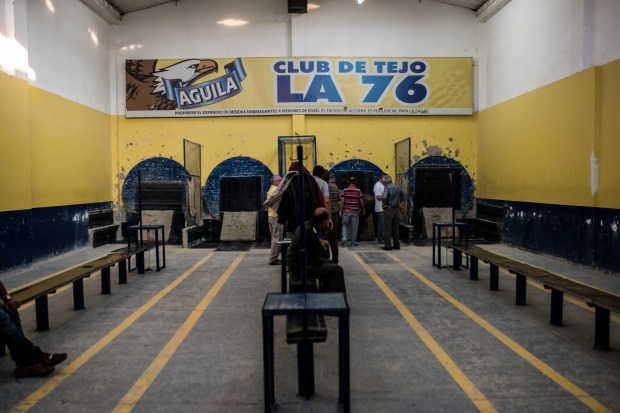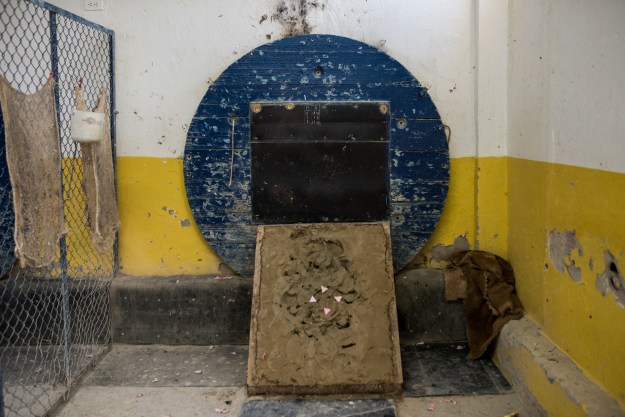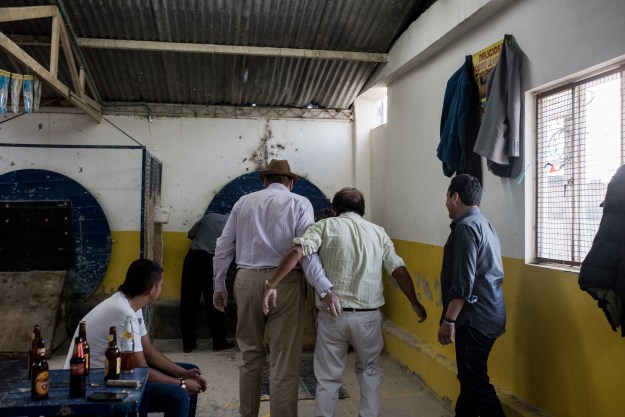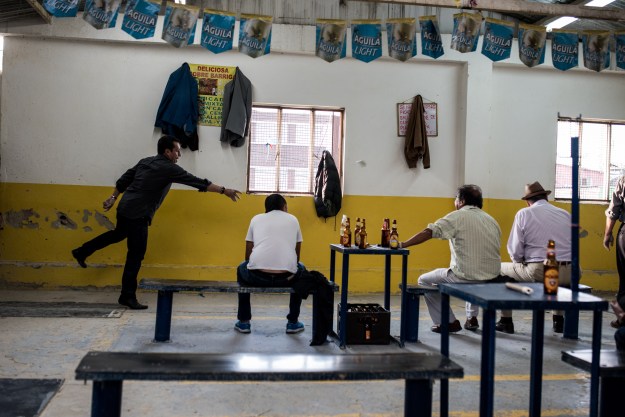In Colombia, it is almost impossible to escape fútbol. On days that the national soccer team plays, the country grinds to a halt for two hours. The streets are deserted, and the bars filled with fans watching the game. Humberto de La Calle, the government negotiator with the Armed Revolutionary Forces of Colombia (FARC) guerillas in the recent peace talks held in Havana, Cuba, said that even the FARC members would show up the day after a Colombia game wearing the national team shirt.
But Colombia’s official national sport is not soccer, it is tejo, designated as such by a 2000 Congressional vote. This is a modernized version of an ancient indigenous game practiced over the past five centuries in central Colombia in the high plateau that runs from the capital, Bogotá, to the region of Boyacá. Since then, tejo has expanded to the rest of the nation, and even some neighboring countries.
This game, which involves hurling metal discs at explosives, usually while holding a beer, captures the fascination of both tourists and locals. But for many Colombians, it has at times been synonymous with uneducated farmers, alcoholics, and vagabonds, resulting in practically nonexistent media coverage. Yet its rich history—shifting from an indigenous tradition, to a way for the powerful to convene, to a game heavily associated with drinking, to a proper sport and a symbol of national identity—has preserved it and propelled it to a place where it can defy class barriers.

Tejo was originally played by the local indigenous Muiscas in the town of Turmequé, in what is now the region of Boyacá, which is why tejo is sometimes also called turmequé. Because of the lack of written or oral histories about the game, it is hard to know exactly how or why it was played. But players and historians of the game believe that the Muiscas played it for one of two reasons: as part of religious ceremonies, or possibly for mere enjoyment.
Many also believe that the indigenous people drank chicha—a fermented corn liquor—while playing, while others say that drinking was forbidden during tournaments. A widespread theory posits that the game was originally played with a golden disc called zepguagoscua but, as the Spaniards arrived, the game started to evolve, changing the gold disc to a stone, and eventually to the metal disc used today.
There is even a legend that women that wanted to be the mate of the cacique (chief) of Turmequé competed in a tejo tournament for the honor.
In its current form—which can be played individually or in teams—players take turns throwing a metal disc (the tejo) into a wooden frame full of clay with a metal cylinder (the bocín) in the middle. Four small triangles filled with explosives (the mechas) are placed over the cylinder.
Landing the tejo inside the bocín is called embocinar, and earns six points. Exploding one of the mechas earns three points. Doing both things at the same time is called a moñona, and earns nine points. If none of these things happen, the player with the tejo placed closer to the bocín gets one point. The first to 27 points wins the game.
Because of its indigenous and rural origins, tejo has long been stigmatized as a lower-class game. In modern times, players often drink beer while they play, and many of the playing fields are at unkempt venues that can be characterized as somewhere between a cheap tavern and a saloon, which has also sullied the game’s reputation.


But in the 1940s tejo enjoyed a brief time in the sun as the pastime of the country’s powerful. Many presidents, former presidents, and political leaders could be found at Campo Villamil, a tejo venue in the Bogotá neighborhood of 7 de Agosto shooting stones while discussing the country’s volatile politics.
For a politician, playing tejo was synonymous with being “a man of the people” (it was almost invariably men who played tejo or held political office), and thus a way to earn the trust of the electorate. According to Guillermo Villamil, the son of the founders of Campo Villamil, former Colombian president Alfonso López explained it this way: “We politicians come to Campo Villami to get votes, but we celebrate our victories at our social clubs.” This is why Colombian Spanish uses the phrase alto turmequé (“high Turmequé”) to refer to the high-class or the powerful elite. To this day, the political gossip pages of El Espectador, Bogotá’s second largest newspaper, are called “Alto Turmequé.”
Maybe the most famous frequenter of Campo Villamil was Jorge Eliécer Gaitán, an immensely popular Liberal leader who was murdered in 1948 in Bogotá. Many believe that he almost certainly would have won the 1950 presidential election. His assassination sparked riots throughout the capital, and ignited a period of Colombian history known simply as “The Violence,” a confrontation between Liberal and Conservative party sympathizers. One of the most iconic photos of Gaitán shows him playing tejo at Campo Villamil while a crowd of political sympathizers looks on.
It’s now common for companies to include the game at their events with clients, and for wealthy families to have tejo boxes in their country houses.
Over time, politicians and the country’s elite lost interest in tejo, instead focusing on the ever-growing sports of soccer and cycling. The middle class followed and the game reverted to being seen as the pastime of rural peasants and poor city dwellers. Campo Villamil was displaced by the growing businesses of 7 de Agosto, mostly brothels and car shops, and eventually closed in 1992. Many other venues remained open in the outskirts of the city and in smaller towns. Most offered a new version of the game called minitejo—exactly the same, except the field is 7 meters long instead of 19.5, and the box is smaller.
In the meantime, some tejo players sought to professionalize the sport. The Colombian Tejo Federation was founded in 1955, organizing leagues mostly in central Colombia, but also organizing national championships. By 1996, tejo was included as part of the National Games (a country-wide version of the Olympic Games). The smaller fields of minitejo allow for kids to start playing from a young age, and now some Turmequé schools offer tejo training as an extracurricular activity.
The media coverage of the sport remains practically nonexistent; tejo champions might be local characters, but they don’t register in the national consciousness. But in the past few years, tejo has begun to lose its stigma, even if in a somewhat kitschy fashion.
Back in the 2000s, one of the venues of choice for young Bogotanos was El Tejo Gomelo (The “Posh” Tejo), a field in the northern outskirts of the city where college kids could play the game, have a drink and then party at night. Today, many of the elegant, rural, country houses that have turned into restaurants in the suburbs of Bogotá offer tejo. It is a feature on the list of amenities for urbanites who want to be entertained by activities associated with the rural landscape.


Playing with the wet clay of regular tejo is messy business, so some companies have started to build tejo boxes to be filled with plasticine, for those who want to play but don’t want to get their hands dirty. You can buy one of these boxes on the internet for about 360,000 pesos ($117 at time of writing), or rent one for 59,000 pesos ($20) per day. A Bogotá company called Fabritejos even sells small tejo boxes that can be folded easily into a suitcase. There are now tejo games for Android and iOS, and there is a patented tejo machine called Tecnotejo.
These new developments, in particular the plasticine boxes, have expanded the acceptance of tejo. It’s now common for companies to include the game at their events with clients, and for wealthy families to have tejo boxes in their country houses, two things that were rare a few years ago.
This doesn’t necessarily mean that people will start tuning into the next national tejo championship—but maybe it means people will start to be more keen on the sport, whether it’s with a beer in hand, or with a medal in their sights.